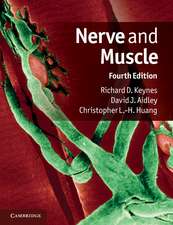Axoplasmic Transport in Physiology and Pathology: Proceedings in Life Sciences
Editat de D. G. Weiss, A. Gorioen Limba Engleză Paperback – 10 apr 2012
Din seria Proceedings in Life Sciences
- 15%
 Preț: 646.75 lei
Preț: 646.75 lei - 18%
 Preț: 952.26 lei
Preț: 952.26 lei - 15%
 Preț: 637.28 lei
Preț: 637.28 lei - 18%
 Preț: 960.61 lei
Preț: 960.61 lei - 15%
 Preț: 648.24 lei
Preț: 648.24 lei - 15%
 Preț: 632.70 lei
Preț: 632.70 lei - 15%
 Preț: 654.43 lei
Preț: 654.43 lei - 15%
 Preț: 635.80 lei
Preț: 635.80 lei - 18%
 Preț: 959.50 lei
Preț: 959.50 lei - 15%
 Preț: 650.37 lei
Preț: 650.37 lei - 15%
 Preț: 636.45 lei
Preț: 636.45 lei - 15%
 Preț: 644.49 lei
Preț: 644.49 lei - 15%
 Preț: 639.08 lei
Preț: 639.08 lei - 15%
 Preț: 641.53 lei
Preț: 641.53 lei - 15%
 Preț: 664.61 lei
Preț: 664.61 lei - 5%
 Preț: 721.77 lei
Preț: 721.77 lei - 15%
 Preț: 652.49 lei
Preț: 652.49 lei - 5%
 Preț: 718.82 lei
Preț: 718.82 lei - 15%
 Preț: 636.80 lei
Preț: 636.80 lei - 15%
 Preț: 646.43 lei
Preț: 646.43 lei - 15%
 Preț: 649.22 lei
Preț: 649.22 lei - 18%
 Preț: 1390.11 lei
Preț: 1390.11 lei - 18%
 Preț: 956.33 lei
Preț: 956.33 lei - 15%
 Preț: 643.48 lei
Preț: 643.48 lei - 15%
 Preț: 641.38 lei
Preț: 641.38 lei - 15%
 Preț: 642.03 lei
Preț: 642.03 lei - 15%
 Preț: 640.24 lei
Preț: 640.24 lei - 15%
 Preț: 651.34 lei
Preț: 651.34 lei - 15%
 Preț: 649.39 lei
Preț: 649.39 lei - 5%
 Preț: 714.06 lei
Preț: 714.06 lei - 15%
 Preț: 640.37 lei
Preț: 640.37 lei - 15%
 Preț: 664.11 lei
Preț: 664.11 lei -
 Preț: 492.59 lei
Preț: 492.59 lei - 18%
 Preț: 945.47 lei
Preț: 945.47 lei - 15%
 Preț: 647.73 lei
Preț: 647.73 lei - 18%
 Preț: 942.01 lei
Preț: 942.01 lei - 18%
 Preț: 943.57 lei
Preț: 943.57 lei - 15%
 Preț: 639.41 lei
Preț: 639.41 lei - 5%
 Preț: 726.15 lei
Preț: 726.15 lei - 15%
 Preț: 641.03 lei
Preț: 641.03 lei - 5%
 Preț: 707.33 lei
Preț: 707.33 lei - 15%
 Preț: 647.27 lei
Preț: 647.27 lei - 15%
 Preț: 638.57 lei
Preț: 638.57 lei - 15%
 Preț: 645.79 lei
Preț: 645.79 lei - 15%
 Preț: 654.12 lei
Preț: 654.12 lei - 15%
 Preț: 652.31 lei
Preț: 652.31 lei - 18%
 Preț: 946.72 lei
Preț: 946.72 lei - 15%
 Preț: 637.28 lei
Preț: 637.28 lei - 5%
 Preț: 718.46 lei
Preț: 718.46 lei - 15%
 Preț: 653.33 lei
Preț: 653.33 lei
Preț: 637.93 lei
Preț vechi: 750.50 lei
-15% Nou
Puncte Express: 957
Preț estimativ în valută:
122.06€ • 127.79$ • 101.00£
122.06€ • 127.79$ • 101.00£
Carte tipărită la comandă
Livrare economică 07-21 aprilie
Preluare comenzi: 021 569.72.76
Specificații
ISBN-13: 9783642857164
ISBN-10: 3642857167
Pagini: 216
Ilustrații: XI, 192 p. 45 illus., 2 illus. in color.
Dimensiuni: 170 x 244 x 11 mm
Greutate: 0.35 kg
Ediția:Softcover reprint of the original 1st ed. 1982
Editura: Springer Berlin, Heidelberg
Colecția Springer
Seria Proceedings in Life Sciences
Locul publicării:Berlin, Heidelberg, Germany
ISBN-10: 3642857167
Pagini: 216
Ilustrații: XI, 192 p. 45 illus., 2 illus. in color.
Dimensiuni: 170 x 244 x 11 mm
Greutate: 0.35 kg
Ediția:Softcover reprint of the original 1st ed. 1982
Editura: Springer Berlin, Heidelberg
Colecția Springer
Seria Proceedings in Life Sciences
Locul publicării:Berlin, Heidelberg, Germany
Public țintă
ResearchCuprins
General Properties of Axoplasmic Transport.- General Properties of Axoplasmic Transport.- Section 1. The Physiological Role of Axoplasmic Transport.- Axoplasmic Transport and Synaptic Transmission.- Effect of Physiological Activity in Goldfish Optic Axons on Axonal Transport of Protein and Nucleosides.- Fate of Axonally Transported Proteins in the Nerve Terminal.- Transneuronal Transport: A Way for the Neuron to Communicate with Its Environment.- Axonal Transport, Neurosecretory Vesicles, and the Endocrine Neuron.- Section 2. The Role of Axoplasmic Transport in Growth and Regeneration.- Axonal Transport in the Sprouting Neuron: Transfer of Newly Synthesized Membrane Components to the Cell Surface.- The Role of Axonal Transport in the Growth of the Olfactory Nerve Axons.- Changes in Fast-Transported Protein in Regenerating Axons: Essential or Incidental?.- Recovery of Axonal Transport of Acetylcholinesterase in Regenerating Sciatic Nerve Precedes Muscle Reinnervation.- The Role of Axoplasmic Transport in the Restoration of Synaptic Transmission and in the Process of Sprouting During Nerve Regeneration.- Section 3. Experimental Neuropathies and Axoplasmic Transport.- Disruption of Axoplasmic Transport by Neurotoxic Agents. The 2,5-Hexanedione Model.- Axoplasmic Transport in the Experimental Neuropathy Induced by Acrylamide.- Axonal Transport in ?,?’-Iminodipropionitrile Neuropathy.- Disulfiram-Induced Impairment of Horseradish Peroxidase Retrograde Transport in Rat Sciatic Nerve.- Section 4. Neuronal Pathology and Axoplasmic Transport.- Axonal Transport in Human Nerve Disease and in the Experimental Neuropathy Induced by p-Bromophenylacetylurea.- Disturbances of Axoplasmic Transport in Alzheimer’s Disease.- Axonal Transport of Acetylcholinesterase Molecular Forms inSciatic Nerve of Genetically Diabetic Mice.- Effects of Graded Compression on Axonal Transport in Peripheral Nerves.- Role of Axonal Transport in the Pathophysiology of Retinal and Optic Nerve Disease.- Implications of Axoplasmic Transport for the Spread of Virus Infections in the Nervous System.- Section 5. Axoplasmic Transport as a Tool in Neurophysiology and Neuroanatomy.- Retrograde Migration of Transmitter-Related Molecules.- Intra-Axonal Transport of Horseradish Peroxidase (HRP) and Its Use in Neuroanatomy.- Axonal Transport of Fluorescent Compounds in the Brain and Spinal Cord of Cat and Rat.

















